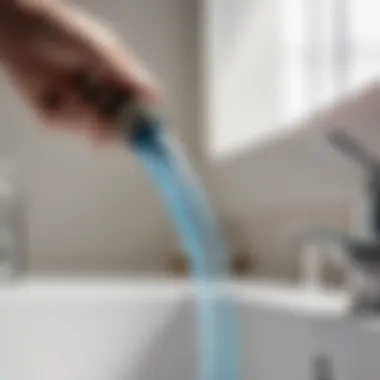Optimizing Your Bathroom Sink Connector Hose: A Complete Guide for Enhanced Functionality


Materials:
- Bathroom sink connector hose (specific measurements needed)
- Adjustable wrench
- Teflon tape
- Pipe cutter
- Towel
DIY Steps:
- Turn off the water supply to the sink.
- Remove the existing connector hose by using an adjustable wrench.
- Measure the length needed for the new hose and cut it using a pipe cutter.
- Wrap the threads of the pipe with Teflon tape to prevent leaks.
- Attach one end of the hose to the sink's water supply, and the other to the faucet.
- Tighten both ends with an adjustable wrench.
- Turn on the water supply and check for any leaks.
Technical Aspects:
- Time needed: Approximately 30 minutes
- Tools required: adjustable wrench, Teflon tape, pipe cutter
- Technique: Ensure proper measurement and sealing with Teflon tape for leak prevention
DIY Project Process:
The installation process of the bathroom sink connector hose involves precise steps and attention to detail. Start by turning off the water supply to the sink to avoid any mishaps. Proceed to remove the existing hose carefully, ensuring not to damage any surrounding components. Measure and cut the new hose accurately to ensure a proper fit. When attaching the hose, make sure to use Teflon tape for a secure seal. Finally, turn on the water supply slowly to test for leaks.
Troubleshooting Tips:
- If you notice any leaks, check the connections and tighten them further if needed.
- Make sure the hose is securely attached to both the water supply and faucet.
- Double-check the measurements and ensure proper sealing with Teflon tape.
Introduction
When it comes to optimizing your bathroom sink connector hose, attention to detail can make a significant difference in the efficiency and longevity of your plumbing system. Understanding the nuances of a connector hose and how it functions within your sink setup is crucial for smooth water flow, leak prevention, and simplified maintenance processes. This comprehensive guide delves into the vital aspects of a bathroom sink connector hose, providing insights that can empower housewives and homeowners to tackle plumbing tasks with confidence.
Understanding the Importance of a Bathroom Sink Connector Hose
Ensuring proper water flow
Ensuring proper water flow is a fundamental aspect of a bathroom sink connector hose. By maintaining consistent water pressure and flow rate, this component plays a pivotal role in the overall performance of your sink system. A high-quality connector hose ensures that water reaches your faucet smoothly, without interruptions or disruptions. Its flexibility and durability contribute to efficient water distribution, enhancing user experience and reducing potential obstructions in water supply. The design of connector hoses prioritizes optimal water flow, making them a reliable and popular choice for homeowners seeking optimal plumbing solutions.
Preventing leaks and water damage
Preventing leaks and water damage is a key function of a bathroom sink connector hose. These hoses are engineered to withstand high water pressures and temperature variations, minimizing the risk of leaks that could lead to water damage in your bathroom. The tight seals and secure connections offered by connector hoses ensure that water remains contained within the plumbing system, reducing the likelihood of costly repairs due to water seepage. The reliability and leak-resistant properties of connector hoses make them a valuable asset in maintaining a dry and well-preserved bathroom environment.
Facilitating easy installation and maintenance
Facilitating easy installation and maintenance is a significant benefit of using a bathroom sink connector hose. These hoses are designed for user-friendly setup, employing quick-connect mechanisms and standardized fittings that streamline the installation process. Additionally, their durable construction and resistance to corrosion simplify maintenance tasks, requiring minimal effort to keep them in optimal condition. The accessibility and hassle-free nature of connector hoses make them an attractive choice for homeowners seeking efficient plumbing solutions that are easy to work with.


Overview of a Bathroom Sink Connector Hose
Materials used
The materials used in a bathroom sink connector hose play a crucial role in its performance and longevity. Common materials include stainless steel, braided nylon, and PVC, each offering unique benefits in terms of flexibility, durability, and resistance to corrosion. Stainless steel hoses are known for their robustness and longevity, making them a popular choice for homeowners looking for long-term reliability. Braided nylon hoses provide a balance of flexibility and strength, ideal for accommodating various sink configurations. PVC hoses are cost-effective and versatile, suitable for basic plumbing setups that require a durable yet lightweight solution.
Types of connector hoses
Connector hoses come in different types to suit varying plumbing needs. Some of the common types include compression hoses, push-to-connect hoses, and threaded hoses, each offering specific advantages based on installation requirements. Compression hoses feature easy-to-use compression fittings that ensure secure connections without the need for specialized tools. Push-to-connect hoses simplify installation with their push-and-twist mechanism that creates leak-proof seals effortlessly. Threaded hoses are versatile and compatible with various faucet and water supply connections, offering flexibility in adapting to different plumbing setups.
Common lengths and sizes
Connector hoses are available in a range of lengths and sizes to accommodate different sink configurations and spatial constraints. Standard lengths include 12 inches, 18 inches, and 24 inches, with custom lengths available for specific requirements. Size variations ensure that connector hoses can fit comfortably between the faucet and water supply without excess slack or tension. Selecting the appropriate length and size of a hose is essential for a tailored installation that minimizes kinks, bends, and aesthetic discrepancies in your bathroom sink setup.
Tools and Equipment Required for Installation
Adjustable wrench
An adjustable wrench is a versatile tool that plays a vital role in securing connections and fittings during the installation of a bathroom sink connector hose. Its adjustable jaw width enables it to grip various sizes of nuts and bolts, ensuring a tight and leak-free attachment. The ergonomic design of an adjustable wrench facilitates ease of use and provides leverage for turning connections with precision. Its durable construction and anti-corrosion properties make it a reliable companion for plumbing tasks, allowing homeowners to tighten fittings securely without damaging surfaces.
Plumber's tape
Plumber's tape, also known as Teflon tape, is a essential accessory for creating waterproof seals in plumbing connections. This thin, flexible tape is wrapped around threaded fittings to prevent water leaks and ensure airtight joints. The non-adhesive nature of plumber's tape allows for easy application and removal, providing a reliable barrier against leaks without causing residue or buildup. Its resistance to chemicals, temperature changes, and pressure fluctuations makes it a go-to solution for enhancing the tightness and durability of connector hose connections.
Pliers
Pliers are indispensable tools for gripping, bending, and compressing components during the installation of a bathroom sink connector hose. Their serrated jaws provide a secure grip on nuts, bolts, and fittings, enabling precise adjustments and tightening. Pliers come in various models, such as slip-joint pliers and adjustable pliers, offering versatility in handling different sizes of objects. The ergonomic handles and rugged construction of pliers ensure durability and comfort during prolonged use, making them essential instruments for completing plumbing tasks with accuracy and efficiency.
This detailed and informative guide aims to equip housewives and homeowners with the knowledge and tools needed to optimize their bathroom sink connector hoses effectively. By understanding the importance of proper water flow, leak prevention, and easy installation, individuals can enhance the functionality and longevity of their plumbing systems with confidence and efficiency.
Installation Process
When it comes to optimizing your bathroom sink connector hose, the installation process plays a crucial role in ensuring a smooth and efficient plumbing system. Proper installation not only helps in preventing leaks and water damage but also facilitates easy maintenance in the long run. Paying attention to each step of the installation process can significantly enhance the performance of your connector hose.
Determining the Correct Hose Length
Measuring the distance between the faucet and water supply
Measuring the distance between the faucet and water supply is a critical step in determining the correct hose length for your bathroom sink connector. This measurement ensures that the hose fits perfectly without any tension or unnecessary bends, thus optimizing water flow and preventing potential damage to the hose. By accurately measuring this distance, you can avoid any issues related to hose length, such as kinking or restricted water flow.


Allowing for flexibility in the hose
Allowing for flexibility in the hose is essential for accommodating any slight movements or adjustments that may occur during regular use. A flexible hose not only makes installation easier but also aids in avoiding strain on the connectors, thereby reducing the risk of leaks over time. This feature enhances the overall longevity and functionality of the connector hose, providing a hassle-free experience for homeowners.
Attaching the Hose to the Faucet
Securing the connection with an adjustable wrench
Securing the connection with an adjustable wrench ensures a tight and leak-free seal between the hose and the faucet. This step is crucial for maintaining the integrity of the connection and preventing any water leakage, which could lead to potential water damage. The adjustable wrench allows for precise tightening, ensuring a secure fit that promotes efficient water flow without any disruptions.
Applying plumber's tape for a tight seal
Applying plumber's tape for a tight seal further reinforces the connection between the hose and the faucet. The tape helps prevent any possible leaks by creating a watertight seal that ensures the long-term performance of the connector hose. This simple yet effective technique is essential for achieving a reliable and durable connection that can withstand the daily usage and water pressure.
Connecting the Hose to the Water Supply
Ensuring a secure fit
Ensuring a secure fit between the hose and the water supply is vital for preventing leaks and maintaining consistent water flow. A secure connection eliminates the risk of water seepage at the joint, safeguarding your bathroom from potential water damage. By prioritizing a secure fit, you can enjoy a reliable plumbing system that functions optimally without any interruptions.
Tightening connections to prevent leaks
Tightening connections to prevent leaks is a fundamental practice that helps in maintaining the integrity of the entire plumbing setup. By securely fastening the hose to the water supply, you can minimize the chances of leaks or drips occurring. This proactive measure enhances the efficiency of your connector hose, guaranteeing a reliable and leak-free operation.
Testing for Leaks and Functionality
Turning on the water supply
Turning on the water supply is a critical step in testing the newly installed connector hose. By examining the water flow and pressure, you can ensure that the connection is secure and there are no immediate leaks. This test validates the effectiveness of the installation process, providing confidence in the functionality of your bathroom sink connector.
Checking for any drips or leaks
Checking for any drips or leaks post-installation is essential for identifying and addressing any potential issues promptly. By carefully inspecting the entire system for any signs of water leakage, you can prevent further damage and take corrective measures if needed. This thorough examination guarantees the reliable performance of the connector hose, instilling peace of mind for homeowners.
Troubleshooting and Maintenance
In this section of the article, we delve into the critical aspects of troubleshooting and maintenance concerning bathroom sink connector hoses. Understanding how to identify and address common issues with these hoses is essential for ensuring the smooth operation of your plumbing system. By focusing on troubleshooting and maintenance, homeowners can proactively prevent potential leaks, damages, and disruptions. Regular upkeep is key to prolonging the lifespan of your connector hose and maintaining the efficiency of your bathroom sink.


Common Issues with Connector Hoses
Leaks at Connections
Leaks at connections are a prevalent issue that can lead to water wastage, property damage, and potential mold growth. Detecting and addressing leaks promptly is crucial to prevent more significant problems down the line. Common causes of leaks at connections include loose fittings, worn-out washers, or incorrect installation techniques. By inspecting connections regularly and ensuring a proper seal with plumber's tape, homeowners can effectively mitigate the risk of leaks and maintain the integrity of their plumbing system.
Kinks or Bends in the Hose
Kinks or bends in the hose can restrict water flow, reduce pressure, and even cause the hose to break over time. It is essential to install the connector hose without any twists or kinks to optimize water flow and prevent potential damages. Choosing a hose with a flexible design and ensuring proper installation are key steps in avoiding kinks or bends. By addressing these issues promptly, homeowners can maintain a steady water supply and prevent unnecessary strain on the connector hose.
Corrosion or Rust Build-Up
Corrosion or rust build-up on connector hoses can compromise their structural integrity and lead to leaks or bursts. Exposure to moisture, chemicals, or aging materials can contribute to corrosion over time. Regular inspection and cleaning can help prevent corrosion or rust build-up by removing debris and mineral deposits. Choosing high-quality, corrosion-resistant materials for connector hoses can also minimize the risk of rust-related issues, ensuring the longevity and performance of your plumbing system.
Maintenance Tips for Prolonging Hose Lifespan
Regular Inspection for Wear and Tear
Regular inspection for wear and tear allows homeowners to detect any signs of damage or deterioration early on. By examining the connector hose for cracks, bulges, or abnormalities, individuals can address potential issues before they escalate. Implementing a routine inspection schedule and replacing hoses at the first signs of wear can prevent leaks, bursts, and water damages, maintaining the reliability of your plumbing system.
Cleaning to Remove Debris or Mineral Build-Up
Cleaning the connector hose to remove debris or mineral build-up is essential for preserving its functionality and preventing clogs. Mineral deposits or debris accumulation can impede water flow and cause blockages in the hose. Utilizing gentle cleaning agents and proper flushing techniques can help homeowners eliminate buildup and maintain optimal water flow through the hose.
Replacing Worn-Out Hoses Promptly
Replacing worn-out hoses promptly is crucial for ensuring the safety and efficiency of your plumbing system. Over time, connector hoses may deteriorate due to age, wear, or exposure to harsh conditions. By proactively replacing worn-out hoses with new, high-quality alternatives, homeowners can prevent leaks, bursts, and potential water damages. Timely replacement of hoses is a proactive measure that can safeguard your plumbing system and promote long-term durability.
Conclusion
In the realm of optimizing your bathroom sink connector hose, the conclusion serves as a pivotal piece of the puzzle, encapsulating the essence of meticulous maintenance and addressing potential issues promptly. Understanding the importance of regular upkeep is crucial to ensuring the longevity and efficiency of your plumbing system. By routinely inspecting and maintaining your connector hose, you not only prevent unexpected leaks and damages but also prolong its lifespan, ultimately saving you time and money in the long run.
Ensuring Optimal Performance of Your Bathroom Sink Connector Hose
Regular maintenance is key
Regular maintenance stands as the cornerstone of preserving the functionality and durability of your bathroom sink connector hose. This practice involves periodic checks for any signs of wear and tear, ensuring that connections remain tight and secure. By incorporating regular maintenance into your plumbing routine, you uphold the integrity of the hose, prevent potential disruptions in water flow, and mitigate the risk of costly repairs down the line.
Addressing issues promptly
Addressing issues with the bathroom sink connector hose promptly is imperative to safeguarding your plumbing system against extensive damages. Whether it's a minor leak or a loose connection, acting swiftly can prevent the issue from escalating and causing more significant problems. By promptly addressing any concerns or malfunctions, you maintain the efficiency of your sink's operations and uphold the overall integrity of your plumbing setup.
Consulting a professional if needed
In some cases, the complexity of plumbing systems may require the expertise of a professional plumber. Consulting a qualified professional can offer additional insights into optimizing your bathroom sink connector hose and resolving intricate issues effectively. While DIY maintenance is valuable, seeking professional assistance can ensure that your plumbing system receives expert care and attention when needed, guaranteeing optimal performance and longevity for your connector hose.







